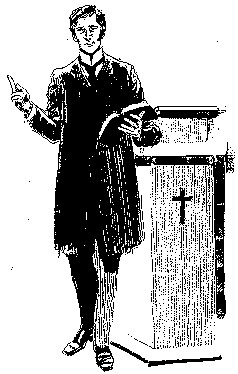 I am amazed at how many followers of Ken Ham believe his suggestions to just
“read it as it is,” when it comes to Bible scriptures.
I am amazed at how many followers of Ken Ham believe his suggestions to just
“read it as it is,” when it comes to Bible scriptures.
Here are some replies I’ve received from Ham fans when I’ve confronted them
with an accurate interpretation of a scripture that Ken Ham has distorted.
“With any other theory, none of us was there. So why would we speculate in a
direction AWAY from the plain reading of God’s Word?”
“I think you are making too much out of the words. If the plain sense makes
sense, seek no other sense.”
“Just because Mr. Ham reads the verses as they are doesn’t mean he changes
the meaning of the words.”
Any Christian leader who teaches his followers that they should depend on
the plain reading of the Word of God is either ignorant of the Bible or is
deliberately deceiving his followers into believing something that is not in
God’s Word.
I use this example often. Matthew 18:6 reads, “But whoso shall offend one of
these little ones which believe in me, it were better for him that a
millstone were hanged about his neck, and that he were drowned in the depth
of the sea.” Let’s go by the plain reading of this text. It plainly says
that if we offend our children we deserve to be drowned in the ocean. Anyone
with half a brain who is aware that the Bible recommends spanking children
for misbehavior would realize this verse means something else. Parents
offend their children by making them clean their room or eat their
vegetables.
We find the answer to this dilemma in the word offend. When it was
translated from the original Greek text into the King’s English, certain
terms had different meanings than they do today. The word offend, in the
original Greek, is skandalizo. It is where our work scandalize comes from.
It means, to entice to sin. This verse is saying that any person who
encourages a child to sin should be punished. I arrested parents who used
their child to shoplift, and charged them with contributing to the
delinquency of a minor. This verse is the first contributing to the
delinquency of a minor law.
But the Answers In Genesis staff has been faced with questions from their
followers about certain Bible passages that appear to conflict with their
teachings. Then the strategy changes. Two separate techniques are used to
eliminate the possibility that their audience will recognize conflict in the
scriptures they are using. One, they totally eliminate that portion of the
scripture that interferes with their theory, and two, change the actual
words in the passage to make them fit the young earth theory.
Let’s take Romans 5:12 as an example. This verse is one of the foundations
of the Young Earth lecturer’s lesson. They teach their followers that Adam’s
sin is the cause of the physical death of animals. This theory is critical
to their claim that dinosaurs could not have died before Adam’s fall. So the
entire Answers In Genesis staff is careful to only read the first portion of
the verse instead of reading the verse in its entirety.
Why not expound on the the rest of the sentence? It’s not even a separate
sentence, its part of the same sentence they read! It says, “and so death
passed upon all men, for that all have sinned.” The Greek word for men is
anthropos, which means a human being, whether male of female. The word also
means “to distinguish man from beings of another order such as animals and
plants.” The death in this verse applies to humans.
The verse continues in the same sentence, “for that all have sinned.” This
can’t apply to animals or plants. They can’t sin! Yet Ken Ham’s bunch
continues to teach that this verse applies to all living creatures when it
does not! Are we depending on the plain reading of the text? I don’t think
so.
Omitting scriptures from their presentations than conflict with their theory
and including only the portion that supports a young earth is common
practice. Take Job chapter 40, that Ken Ham claims is describing a dinosaur
living in Job’s day. The entire description of Behemoth starts at verse 15
and ends at verse 24. But the entire Answers In Genesis staff only show
their audiences verses 15 through 19. That’s because they can twist the
meaning of those verse so the description fits a dinosaur instead of an
elephant. Verses 20 through 24 describe an elephant picking up water with
its trunk, laying under the Lotus trees, and sticking its trunk through the
bars of a cage, all things a brontosaurus could never do! Are we depending
on the plain reading of the text? I don’t think so.
And the verses they do read from this chapter, they modify to fit their
description. Verse 19 reads, “he moveth his tail like a cedar.” Let’s take
the plain reading of the text. What is the text saying? It is describing the
movement of the elephant’s tail back and forth as it walks, just like a
Lebanese cedar tree swaying in the wind. How does Ken Ham spin this verse?
He claims the creature has a “huge tail,” and an “enormous tale.”
In the original Hebrew, and in the English translation, there is nothing
close to a descriptive adjective that describes a huge tail. There is not
one word that describes what this tail looks like. There is one action verb,
chaphets, which means moveth, that describes the action of the tail. And
there is nothing in the plain reading of the text that tells us this
creature has a long neck. In fact, the neck isn’t even mentioned in this
passage, probably because the elephant doesn’t have much of a neck. Are we
depending on the plain reading of the text? I don’t think so.
Answers In Genesis encourages their followers to depend on the plain reading
of the word, as long as the plain reading supports their theory. But on
occasion, Ken Ham has been faced with the need to explain away scripture
that conflicts with the young earth theory, and he cannot defend his theory
without changing the meaning of the Word of God.
In those cases, Ken Ham has concocted some of the most ridiculous
interpretations of scriptures that I have ever seen in my years of studying
the Bible. For instance, Ken Ham is faced with a dilemma in Genesis 2:17,
when God warns Adam of the penalty of eating the fruit of the tree of the
knowledge of good and evil. It reads, “But of the tree of the knowledge of
good and evil, thou shalt not eat of it: for in the day that thou eatest
thereof thou shalt surely die.” Surely die is twm muwth, which means to be
executed. God promises Adam that if he ate the fruit, he would die that day.
Adam ate the fruit. He didn’t physically die that day. Ken ham insists that
Adam’s sin is the cause of all physical death, but this verse appears to
show that God was not talking about physical death. So Ken Ham teaches that
the term “surely die” in Genesis 2:17 means that the “process” of death
started, and that Adam would eventually die down the road someday.
Ken Ham is either totally ignorant of what Genesis 2:17 says, or he is
trying to deceive his audience. Now he is encouraging his audience to not
depend on the plain reading of the text, which states that Adam would die
the same day he ate the fruit. Ken Ham has also included animals and plants
in with this curse. But Adam didn’t physically die that day. So this verse
cannot be referring to the physical death of anything. So Ken Ham has to
make up an explanation for this verse so it doesn’t totally destroy his
claim that Adam’s sin is the cause of the physical death of animals.
The Answers In Genesis staff, and other Young Earth teachers, are the only
group that falsely teach that “surely die” is describing a slow process of
death. The term surely die is the Hebrew word muwth used twice, but in
Hebrew, it doesn’t mean “dying you will die,” which is one of the silliest
explanations of this verse ever invented! In the context used in this verse,
the Hebrew language is saying that when Adam ate the fruit, he would
positively die, or unequivocally die. The two Hebrew verbs used together
make the result emphatic, without question. For Ken Ham to defend his
theory, he is forced to change the definition of this term.
He would also have of change the meaning of Exodus 21:12, where we read
about the death penalty for murder. The exact same literary structure is
used in Exodus 21:12 as it is in Genesis 2:17. It states, “He that smiteth a
man, so that he die, shall be surely put to death.” Surely put to death is
also muwth used twice. And this verse doesn’t mean the penalty for murder is
a long drawn out process. If it did, the penalty for murder would involve a
person starting the process of dying and eventually dying years down the
road. Are we depending on the plain reading of the text? I don’t think so.
These actions are unconscionable. When it comes to scripture twisting, the
staff at Answers In Genesis are professionals. And when providing a false
interpretation of a word doesn’t suit their needs, they blatantly change the
word.
In the account given in Genesis chapter one there are two separate and
distinct words used describing God’s work.
The first word used is created, which in the original Hebrew, is bara’. It
means to create something out of nothing. The second word is made, which is
`asah. It means to fashion out of existing materials. And at the end of the
sixth day, in verse 31, God states, “And God saw every thing that he had
made, and, behold, it was very good.” That, is the plain reading of the
text. But Ken Ham changes the word. In every one of their presentations, the
Answer In Genesis teachers state, “And God saw every thing that he had
created, and, behold, it was very good.”
Again, verse 31 does not say that everything that God created was very good.
The whole staff at Answers In Genesis ignores the plain reading of the text
and actually change the words in the Bible in order for the scriptures to
fit their theory. They would love for verse 31 to say that everything God
created at the end of the sixth day was very good, but that’s not what the
Bible says. So they change the word. Are we depending on the plain reading
of the text? I don’t think so.
So when you hear a Young Earth Creationist claim that they depend on the
plain reading of the word when it comes to Biblical doctrine, you can be
sure of four things. One, they misunderstand what the plain reading really
says. Two, they are unaware of additional scriptures that have been
deliberately omitted. Three, they believe a false interpretation of a word
that Ken Ham has provided them. And four, they are unaware that an actual
word has been replaced with another word. In other words, if they have
listened to Ken Ham, they have no clue what the Bible really says.

